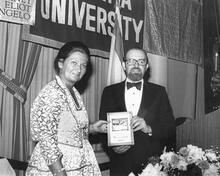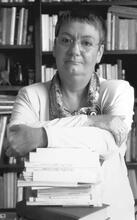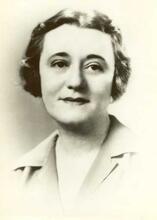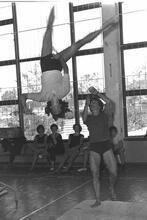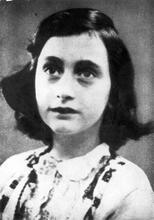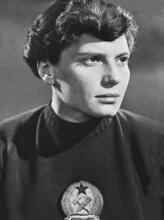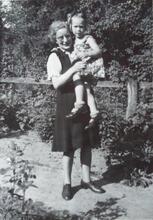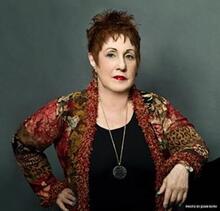Sports in Germany: 1898-1938
Sports were a way for the assimilated Jewish German community to publicly demonstrate its status. Women’s participation in Jewish gymnastics increased significantly during the first two decades of the twentieth century. Even before WWI, woman members of Jewish clubs had the same rights as their male counterparts, and female coaches were trusted to train woman gymnasts. Jewish women also founded their own clubs. The Jewish community grew its sports movement during the 1920s – women now participated in cross-country running, swimming, and tennis. After German sports clubs banned Jewish membership in 1933, women poured into Jewish sports groups, and membership continued to grow with the rise of National Socialism. Hitler only permitted “half-Jews” to represent Germany in the Olympics. After Kristallnacht in 1938, all remaining Jewish sporting activities were terminated.
Sports & Assimilated Middle-Class Status
From the 1890s, despite fierce resistance, German women increasingly participated in gymnastics, games and other sporting activities. Furthermore, in 1894 gymnastics lessons became obligatory at girls’ secondary schools in Prussia. Nevertheless, women were a tiny minority in athletics and sports organizations, in which they had no say.
Although even “Eastern Jewish” (Ostjüdische) women and girls encountered new opportunities for exercise, such as gymnastics and dance, the greatest impact of sport as a sign of modernity was on Jewish women who were already integrated into German culture—middle-class women with enough leisure time and wealth to engage in such activities as gymnastics, skating and tennis, many of which were also occasions for social gatherings. Sport became a way for the “assimilated” Jewish community to end its marginalization and publicly demonstrate its social status and aspirations. The fact that in the 1920s the list of highest-ranking German tennis players was headed by Jewish women indicates not only the sporting opportunities available to such women and their dedication to success, but also the recognition given them in the Weimar Republic.
It is not possible to estimate today how many Jewish women participated in non-Jewish gymnastics and sports clubs. Although Jews were rarely refused membership in a gymnastics or sports club, there is sufficient evidence in many clubs of antisemitic tendencies and discrimination towards Jewish members. Nevertheless, one can assume that far more Jews belonged to general sports clubs in which neither religious nor cultural affinities played a role than to strictly Jewish ones. For many Jews joining a purely Jewish gymnastics or sports club would not have been in keeping with their identity as Germans. Possible reasons for the attraction of non-Jewish sports clubs include the desire to be fully integrated into German culture on the one hand as well as the good training facilities of these clubs on the other. The top level athletes—Lilli Henoch, Gretel Bergmann and Helene Mayer—for example, were accepted and recognized members of non-Jewish athletic clubs before Hitler seized power.
Women in the Jewish National Gymnastics and Sports Movement
The Jewish gymnastics and sports movement propagated a new type of Jewish physical awareness. Its aim was to replace the stereotype of the feeble, stooped Jew by “muscular Jews,” the so-called “Muskeljudentum (muscular Jews).” Although the propagators of this new Jewish self-image argued that the poor state of health of large sections of the Jewish population had historical causes, it is clear that in principle they accepted biological arguments.
The discourse on gymnastics and sport for women was embedded in the overall concept of the Jewish gymnastics movement, whose ultimate goal was to promote health, strength, and self-awareness in the Jewish community. The early integration of women into the Jewish National gymnastic movement not only aimed at improving physical fitness among girls and women but also pursued political and ideological objectives. “Increasing the nation’s strength” seemed to depend on the physical constitution of women, who were expected to bear strong sons. Besides this, a good psychological constitution and a positive attitude toward physical fitness were imperative for mothers, since they were ultimately responsible for raising their children. Women were also encouraged to be strong in both mind and body in order to meet the requirements of paid employment, sought by increasing numbers of women. Moreover, gymnastics was considered a means of making girls and women aware of Judaism and of introducing them to the Zionist movement. Last but not least, strong and healthy women were needed for the emigration to The Land of IsraelErez Israel.
Integrating Women
Only two years after its founding in 1898, women’s sections (first for adult women and soon afterward for girls) were set up by Bar Kochba Berlin, the first Jewish gymnastics club in Central Europe, which played a leading role in the Jewish gymnastics movement. In 1903 there were already 129 female members of the club, constituting 34 percent of its membership—a far higher figure than in most organizations in the Deutsche Turnerschaft (German Gymnasts’ Association). However, Bar Kochba Berlin was initially an exception: in 1906 not even a quarter of all Jewish gymnastics clubs had established female sections. But in 1907, at the third Jewish Gymnastics Meeting of the Jüdische Turnerschaft (Jewish Gymnasts’ Association), founded in 1903, an intensive publicity campaign was launched to promote female gymnastics. This campaign was so successful that by 1912 eighty percent of all Jewish sports clubs affiliated with the Association had women members. Overall female membership in 1912 was just under 38 percent. During World War I this figure increased to 63.4 percent in 1917. It is hard to estimate the significance that Jewish gymnastics clubs had in the integration of female Jewish immigrants from Eastern Europe. It is likely that the barriers facing Eastern Jewish women in becoming members of clubs were much greater than for the men because of their being strongly bound to traditional female roles. This is indicated at least by the fact that in 1903 Bar Kochba Berlin established a section for Eastern Jewish male gymnasts, while the opening of a section for Eastern Jewish female gymnasts was apparently not ever considered.
Despite their specific goals, the everyday organization of Jewish gymnastics clubs was very similar to that of non-Jewish clubs; the practice regimen for women was restricted to free-style and choreographed exercises, exercises with dance elements (Reigen) and gymnastic games as well as simple exercises on apparatus. Further obstacles confronting female gymnasts were phenomena that were equally widespread in the Deutsche Turnerschaft, such as ideals of beauty, medical and other prejudices, and the gymnasts’ attire commonly worn at that time—a quite impractical blouse and long skirt.
The misgivings about women performing gymnastics on apparatus and the criticism of the so-called “excesses” of physical exercise, both of which were prevalent in the Jewish gymnastics movement, too, culminated in the fear men had of women’s “masculinization”: “Our womenfolk should not be ‘masculinized’ through physical education, but should strive after health, strength, endurance and agility within the borders of femininity” (Jüdische Turnzeitung 3 [1902]: 137).
Despite these critical voices, the concepts of the games and sports movement as well as principles of performance were quickly adopted by female gymnasts in Jewish clubs. The games and exercises were gradually extended to include more difficult exercises on apparatus, and occasionally supplemented or even replaced by track and field disciplines. Clothes were also adapted to accommodate the changes in exercises. In 1913 the Jüdische Turnerschaft’s chief coach described the changes in female gymnastics in the following terms:
“The long skirts and high-heeled shoes of the dancing gymnasts have vanished; today, even in the most conservative clubs, trousers, running shoes and blouses are the prescribed athletic attire. It is no longer considered unladylike to swing daringly on the parallel bars, the horizontal bar or the rings, and to vault over the horse and buck with genuine gymnastic enthusiasm.”
The participation of women in gymnastic displays was rarely discussed in the Jewish gymnastics movement, in contrast to the Deutsche Turnerschaft, where this was a controversial issue. The appearance of female gymnastic teams had more to do with publicity and advertising than anything else, especially as the Jewish gymnastics movement, which had to compete with the traditional and well-equipped “neutral” clubs, was very much dependent on advertising. Even more publicity than in these gymnastic displays was to be gained by holding gymnastics or sports competitions—a fact soon recognized by the Jewish gymnastics movement. Although the participation of women in competitions was a controversial topic in the Jüdische Turnzeitung (Jewish Gymnasts’ Newsletter), there was a steady increase in the number of women’s competitions. It was primarily the female gymnasts themselves who demanded the admission of women to competitions.
Gender Equality in Jewish Gymnastics Clubs
Even before World War I, women members seem to have had the same rights and obligations as the male members of Jewish gymnastics clubs. In 1911 Betti Eger, a member of the executive committee of Bar Kochba Berlin, noted that “Every single female club member has active and passive voting rights. Women have sat on the committee for years” (JTZ 12 [1911]: 73).
Since 1900, moreover, the leaders of the women’s sections had had a place on the executive committees in accordance with the clubs’ statutes. Women’s voting rights were also anchored in the statutes of the umbrella organization, the Jüdische Turnerschaft, founded in 1903.
The women made full use of their decision-making powers: they demanded, for example, that the women’s sections should be headed by women. Even though in the Jewish gymnastics movement, too (as, for example, at the Second Jewish Gymnastics Meeting in 1906), the leadership qualities of women were questioned even by female members, the principle of entrusting women’s and girls’ gymnastics to female trainers and coaches was nevertheless established. Thus, the demand for “female leadership,” still to be heard in the bourgeois and proletarian sports movement in the 1920s, had already been met by the Jewish sports movement in Berlin even before World War I.
Independent Women’s Clubs
Like non-Jewish gymnasts and sportswomen, Jewish women founded their own clubs, the largest and most important of which was the Jüdische Frauenbund für Turnen and Sport (Jewish Women’s Association for Gymnastics and Sport) (Ifftus), established in 1910 by the leaders of the women’s sections of Bar Kochba Berlin and many of its members.
According to the chronicler of Bar Kochba Berlin, Dr. Robert Atlasz (1898–1990), it was the “deep sense of dissatisfaction with the gymnastic leadership” that led to the “these undisciplined mass terminations of membership” (Atlasz 1977: 12). But it is also possible that conflicting political views and differing outlooks, specifically regarding Zionism, contributed to this. Ifftus, at any rate, was an unequivocal supporter of Zionism and very active in the Jewish National education of girls and women. This new club quickly found a large following, offering a new athletic home to women, such as Kaete Dan-Rosen, who did not feel as if they were “quite in the right place” in the Deutsche Turnerschaft. In 1912 Ifftus became affiliated with the Jüdische Turnerschaft and by 1914 it had 181 members. Each of the three women’s sections was run by a qualified female gymnast, and altogether there were fourteen exercise group leaders.
Ifftus offered its women members a diverse program which included fencing and tennis as well as gymnastics. Not only the club’s own members but also women’s gymnastics and sport as a whole profited from its activities, since its executive committee members had seats in various important sporting bodies. Although Atlasz may have regretted the split caused by Ifftus, all in all the new situation brought women more advantages, since Bar Kochba was now forced to intensify its work in furthering women’s gymnastics in order not to lose its female members to the rival club. Against the background of steadily worsening living conditions, Ifftus and Bar Kochba Berlin grew closer again during World War I. By the mid–1920s, the members of Ifftus rejoined Bar Kochba Berlin.
Jewish Gymnastics During the Weimar Republic
During World War I, women, whether as officials or as ordinary members, ensured the continuation of the Jewish gymnastics clubs. Nevertheless, after the war they were once again replaced by men in the club committees and association councils, with the result that women’s affairs were paid little attention. In 1930, in order to intensify its work in women’s gymnastics, Bar Kochba Berlin established the position of a “women’s commission in the executive committee” similar to those in “neutral” gymnastics and sports associations. The main responsibilities of these women’s commissions were publicity and education.
After World War I, female membership in Jewish gymnastics and sports clubs remained relatively high. In the German Makkabikreis (branch), the percentage of female members constituted thirty-eight percent according to figures published in 1924; the corresponding figure for the Deutsche Turnerschaft was only twenty percent. In Bar Kochba Berlin women actually constituted the majority of active adult members in 1924: in the over-eighteen age category, there were 142 female as compared to only one hundred male members.
With regard to the role of women in the German Makkabikreis, one can affirm that the percentage of female members was unusually high compared with non-Jewish clubs and associations, and that women were recognized as equal members relatively early. Moreover, the principle of “women as leaders” was established in many women’s sections. Nevertheless, even the women of the Jewish gymnastics and sports movement did not succeed in occupying powerful positions. Charlotte Ullmann, a member of Bar Kochba Berlin since 1931 and a participant in the first Maccabiah in Tel Aviv in 1932, stressed in a letter dated May 11, 1989, that “there was no discrimination of women in Bar Kochba. We all had the same rights and took part in all the sports we could.” However, in another passage she also mentioned that “the leadership of the Makkabikreis was in the hands of men and I don’t remember that there were any women in leading positions.”
Growth & Controversy in the Jewish Sports Movement
The victory of sport over other forms of physical culture and its spread throughout Germany in the 1920s did not fail to influence the Jewish gymnastics movement, which despite criticism about the “excesses” of sport progressively developed into a sports movement. Women, too, participated in ever greater numbers in the growing variety of sporting activities. Besides gymnastics on apparatus and the increasingly popular track and field disciplines, women in the Jewish gymnastics and sports movement now had the opportunity to go cross-country running or swimming, play team handball, hockey, “fistball,” or tennis, and take up fencing. Several women team handball and hockey players from Bar Kochba Berlin even participated in a New Year’s football match on Sunday, January 1, 1933.
The more popular women’s sports became, the less men were inclined to control women and limit them to “feminine” exercises. As late as 1924 Arthur Loewenstein had suggested putting restrictions on “strenuous exercises on apparatus” and replacing track-and-field disciplines with round-dancing gymnastics. This opinion soon seemed old-fashioned.
However, the participation of women in competitive sports was a controversial question in the Jewish sports movement, just as it was among the bourgeois public. The most important watchword was caution: in 1929, for example, it was suggested in an article published in Der Makkabi magazine that the effects of competitive sport on women’s health, physical development and “aesthetics” should be evaluated. The author comes to the conclusion that “too frequent participation in competitions” is to be rejected since its “consequences are deformations of the body structure, organ damage and the associated irritation of the nervous system” (Der Makkabi 1929, H9 12). However, the desire to prove Jewish athletic capability was evidently stronger than concerns about the effects of competitive sport. One finds repeated criticisms in the sports press about the lack of enthusiasm for training among female Jewish athletes, who in the 1920s took part in organized competitions in increasing numbers, but not always successfully. By 1919 women’s events in various track-and-field disciplines had already become a regular part of the program of Jewish sports meetings.
Since Jewish gymnastics and sport clubs were fully integrated into the general sports movement, both male and female teams took part in the many sport festivals, competitions, and league games that were held in various ball games. One outstanding event in the Berlin sporting calendar, which was also particularly effective in terms of publicity, was the annual Potsdam to Berlin relay race, in which the important thing for Jewish clubs was to “defend the name and reputation of Bar Kochba-Hakoah and all Jewish sport besides” (Der Makkabi 1932, H2 14). For this reason, Bar Kochba Berlin recruited as many teams as possible, both male and female, to compete. Since success in the Potsdam to Berlin race was seen as proof of a club’s excellence and could also enhance its prestige for a long time afterward, the female runners were spurred on to give their last drop of energy, even though this ran counter to the traditional myths of femininity: “Every runner must be aware during the competition that each meter that they struggle for may be the deciding one. So from the first meter to passing the baton, there can be only one thought pounding through their heads: victory!” (Der Makkabi 1932, H2 14). Resistance in the Jewish gymnastic movement to extending the repertoire of exercises or to participation in gymnastic displays and competitions was significantly less than in the Deutsche Turnerschaft. This may be connected with the gender roles of Jewish culture, which were not based on the polarity of female weakness and male strength. The furthering of female sports in the Jewish gymnastics and sports movement may, however, also be seen in the light of Jewish political and social views and the Jews’ minority status. On the one hand, fulfillment of Jewish national and Zionist goals was possible only with the help and inclusion of women. Moreover, the achievements of female Jewish athletes could help to counteract antisemitic stereotypes. On the other hand, the Jewish gymnastics and sports clubs especially attracted those women of Jewish Nationalist orientation. They offered their members much more than an opportunity to participate in sporting activities: the celebration of Jewish festivals, the Heimabende (discussion evenings) with entertainment and talks, the trips and excursions all nurtured close-knit relationships among members, giving the individual a sense of shelter and support in an increasingly hostile environment.
Reichsbund Jüdischer Frontsoldaten (Jewish Front-Line Soldiers)
The participation and position of women in the Jewish National gymnastics and sports movement can be reconstructed, in broad outline at least, from such sources as the Jüdische Turnzeitung, which has come down to us in full and whose numerous reports and contributions also reveal something about its program and its goals. By contrast, the role of women in the sports groups of the Reichsbund jüdischer Frontsoldaten (Jewish Front-Line Soldiers) (RjF) as well as in the Verband jüdisch neutraler Turn- and Sportvereine (Association of Jewish Neutral Gymnastics and Sports Clubs) (Vintus) is still largely unknown due to insufficient documentation.
In 1919, the Reichsbund jüdischer Frontsoldaten was founded by former Jewish front-line soldiers in order to combat antisemitic attacks and to counter accusations that the Jews had shown themselves to be cowards during World War I. By definition, this was a men’s association; members were former Jewish soldiers who had taken part in the war, and thus excluded not only women but also young males.
The first sports groups of the RjF came into existence in 1923–1924 at a time of antisemitic violence and primarily served as “self-protection.” They were called Schild (shield). In the period that followed, systematic recruitment took place for the formation of sports groups. Since according to its statutes only former front-line soldiers were eligible to join the RjF, the sports groups were merely affiliated with the RjF, and were thus “not strictly part of the RjF” (Dunker 1977, 103). Now that their responsibilities were no longer limited to self-protection, they were expected to contribute not only to improving the general physical fitness and health of the Jews but also to recruiting young people and countering antisemitic prejudices. “The victorious Jew is the best propaganda against all the antisemitic lies” (Meisel 1926, 112). Unlike the Makkabi, the RjF and its sports groups professed their affinity with German culture and German national traditions. Their goal was to train members to adopt soldier-like virtues such as a readiness to defend the fatherland. With regard to sport, their goals were to be accomplished by playing those types of sport which were thought to build up courage and a fighting spirit. Emphasis was thus placed on “combative” sports such as boxing and jujitsu. However, the proponents of this movement failed to realize that they had succumbed at least implicitly to antisemitic patterns of thought: The hope that Jews would prove their “Gleichwertigkeit”—their equality in worth—through physical fitness and a soldier’s training was inseparably linked with the idea that physically weak or fearful people are indeed “inferior.”
The picture of the human being prevalent among the sports groups of the Schild, the values which were propagated, and the preferred sports were all obviously aimed at young men. Nevertheless, shortly after the formation of the first groups, women’s and girls’ sections were also established. Although the participation of girls and women in gymnastics was accepted and to some extent encouraged, from the mid–1920s on, female sports were not generally given much attention. Before 1933 women’s sport was treated as a side issue in the RjF’s newsletter, the Schild. The fact that women’s or girls’ sections existed at all can often be gleaned only from brief announcements of club events and their results. There is no information on either statistics or the clubs’ official policies on the role of women in sport, such as was quite common in the journals of other sports organizations in the 1920s.
Women Join the Jewish Front-Line Soldiers
Only after the exclusion of Jewish members from “German” sports organizations in 1933, when girls and women poured into the newly established “Schild Sportbund des Reichsbundes jüdischer Frontsoldaten” (Sports Association in the Reichsbund of Jewish Front-Line Soldiers), did the “women’s question” become an issue. In accord with a clearly eugenic tendency, the yardstick for evaluating women’s sports was their compatibility with a woman’s duties as housewife and mother. Accordingly, the guidelines on women’s sports, drawn up by Martha Wertheimer, were predominantly warnings against achievement-oriented sports and against the destructive effects of competition and its negative impact on the family and community.
The entire orientation of the RjF, especially its emphasis on male and soldierly values, ascribed only a marginal role to women in the sports groups before 1933. There is every reason to suppose that the establishment of women’s sections was attributable to the RjF’s eugenic objectives and possibly also the result of competition from the Jewish national clubs.
In the Vintus, too, women and girls were integrated with their own sections from the very beginning. However, it can also be assumed that here too, women’s sport played only a minor role. On the basis of the sources available, it is not possible to estimate with any accuracy which types of sports or athletic disciplines predominated in the club activities provided for girls and women. Track and field as well as swimming presumably played a significant role in addition to gymnastics.
Sports under National Socialism
When the National Socialist party seized power, sport was immediately made to conform to the new ideology. Without being compelled by legal regulations or by order of the authorities, gymnastics and sports organizations made the decision to exclude Jewish members, a measure that was carried out with unprecedented ruthlessness. In addition to the countless acts of discrimination which made the daily lives of Jews in Germany increasingly difficult, there was now the loss of their “home” in gymnastics and sports.
However, Jews were still able to participate in sports in the Jewish sports organizations, and there was a marked increase in the membership of the Makkabi clubs as well as in those of the Sportbund Schild. Despite the many restrictions and increasing emigration, between the end of 1933 and 1935 membership in the German Makkabikreis rose from approximately 10,000 to 22,000 and from approximately 7,000 to 18,500 in the Sportbund Schild. In consequence, the sporting activities of the clubs grew, and in many types of sport regular competitions and championships were organized in addition to the sports festivals.
The question of Jewish participation in sports in Germany became a volatile issue with the approach of the Olympic Games. Hitler finally had his way and succeeded in refusing to allow Jews to represent Germany in the Olympic stadium. Only Helene Mayer and Rudi Ball, who according to the National Socialist definition were “half-Jews,” were permitted to join the German team.
After the Olympic Games, the National Socialist regime no longer paid any heed whatever to opinion abroad. The Jewish sports movement was given only a brief “period of grace,” although this, too, was marked by further restrictions. With the pogrom of November 9 and 10 (“Kristallnacht”1938), any remaining sporting activities in Jewish clubs came to an end. The Jews were no longer fighting for athletic distinction; their everyday lives were now determined by their fight to survive.
For more information about Jewish physical activities and sports in Germany visit https://www.deutschlandfunk.de/leib-und-leben-das-judentum-und-der-sport.2540.de.html?dram:article_id=422575 (German)
Atlasz, Robert. Bar Kochba. Makkabi-Deutschland 1898–1938. Tel Aviv: Hit’ahdut Havre Bar Kokhva ha-Koah Leshe-‘avar, 1977
Bergmann, Gretel. ’Ich war die große jüdische Hoffnung.’ Erinnerungen einer ausergewöhnlichen Sportlerin. Karlsruhe: Braun, 2003
Bernett, Hajo. “Der deutsche Sport im Jahre 1933.” Stadion 7 (1981), 225–283
Bernett, Hajo. Der jüdische Sport im nationalsozialistischen Deutschland. Schorndorf: Hofmann, 1978
Bernett, Hajo. Die jüdische Sportbewegung in Deutschland 1898–1998. Wien: N.p., 1998
Dunker, Ulrich. Der Reichsbund jüdischer Frontsoldaten 1919–1938. Geschichte eines jüdischen Abwehrvereins. Düsseldorf: Droste, 1977
Friedler, Eric. Makkabi chai—Makkabi lebt. Die jüdische Sportbewegung in Deutschland 1898–1998. Wien: Brandstätter, 1998
Lämmer. Manfred, ed. Die jüdische Turn- und Sportbewegung in Deutschland 1898–1938. Sankt Augustin: N.p., 1989
Mayer, Paul Yogi. “Equality—Egality: Jews and Sport in Germany.” In Leo Baeck Institute Yearbook 25, 221-241. London: 1980
Meisl, Willy. “Der notwendige Sport.” Der Schild 5 (1926): 112
Pfister, Gertrud, and Hans Langenfeld. “Die Leibesübungen für das weibliche Geschlecht: ein Mittel zur Emanzipation der Frau.” In Geschichte der Leibesübungen 3.1., edited by Horst Ueberhorst, 485–521. Berlin: Bartels & Wenitz, 1980
Pfister, Gertrud, and Hans Langenfeld. “Vom Frauenturnen zum modernen Sport—Die Entwicklung der Leibesübungen der Frauen und Mädchen seit dem Ersten Weltkrieg.” In Geschichte der Leibesübungen 3.2, edited by Horst Ueberhorst, 977–1008. Berlin: Bartels & Wenitz, 1982
Teichler, Hans Joachim. “Zum Ausschluß der deutschen Juden von den Olympischen Spielen 1936.” In 30 Jahre jüdische Sportbewegung im Nachkriegsdeutschland, edited by E. Friedler and M. Lennarz, 47–62. München: N.p., 1995
Teichler, Hans Joachim. Internationale Sportpolitik im Dritten Reich. Schorndorf: K. Hofmann, 1991.

